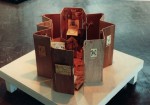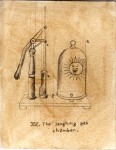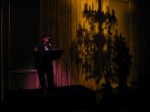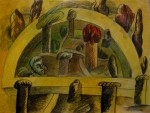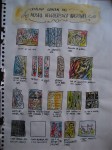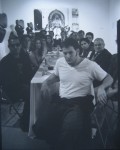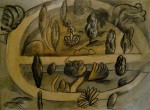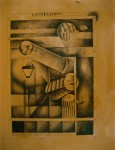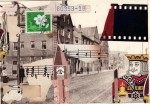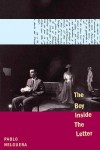Everything in Between / The Boy Inside the Letter
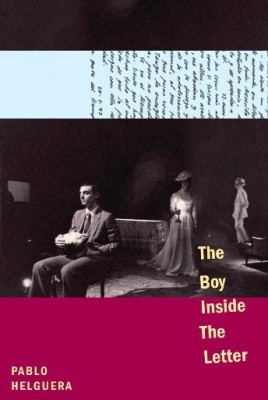
Everything in Between / The Boy Inside the Letter (2007) is a site-specific project made for the Queens Museum exhibition “Generation 1.5”
.
The project consists in two components: one, a multi-media installation showcasing diaries and artworks made between the ages of 17 to 21 (1988-1992), which cover a crucial transition from Mexico to the U.S. as well as art school years in Chicago and Barcelona. A recording narrates, in twenty sections, various of these entries.
The second component of the project is a short novel incorporating some of these diary entries, and written in the style of the Künstlerroman (or novel of artistic education). The book’s title is The Boy Inside the Letter and was published in 2008 by Jorge Pinto Books in New York.
The years documented in this project (1988-1992) were key to my development as an artist. My threefold quest for adulthood, national and artistic identity took place during those years, and much of my experiences then cemented a good part of my outlook on art and culture. I left Mexico City as a teenager wanting to be a muralist, and toward the end of this four-year period I was making conceptual art, questioning nationalism and most of the ideas about art that I had started with in the first place. The best way, in my mind, to present this complex period was to show some of the actual artworks and writings that I produced at that time. Artists often do not show their student or early work, due to understandable concerns as to its raw character and yet-to-be developed technique and ideas. But I felt it would be helpful to lift the curtain in this case, in order to showcase the complex web of ideals, infatuations, dilemmas and uncertainties that are somewhat true of every adolescence, and which perhaps acquire a heightened quality in the experiences of an immigrant teenager who is trying to become an artist.
(excerpts of the book below)
Information on Queens Museum Exhibition
Three excerpts from The Boy Inside the Letter
ORO NO SONORO
Once again You are back, but this time in order to open that box down in the basement, sealed nearly twenty years ago, with Your name on it, waiting for this day.
The first thing is this sense of space, that open space that every springtime is spitefully cold but also enormously liberating, allowing one to deeply breathe the cold air from the bottom of one’s lungs, a total relief from the urban claustrophobia of where You are coming from. And yet, despite the Midwestern amplitude of this city everything nonetheless seems a little simpler and innocent, too naïvely clean, with carefully arranged flowerpots, like the setting for a children’s tale. Welcome to Chicago’s Midway Airport, Richard M. Daley, Mayor. On the moving walkway, You go past Harry Carray’s Seventh Inning airport Bar and think about that kind of local histories that never travel well. You still picture Your smiling dad at the passenger exit, next to the escalators with his puffy blue navy jacket and the car keys in his hand, still honoring the waning family tradition of awaiting each other at airports. That is just the introductory image of this city plagued by all the ghostly mirages and talking paintings that You know so well. The second thing is getting coffee at a Dunkin Donuts, because it reminds You that it was the only place open downtown during those student times of all-nighter performance rehearsals. And then it is essential to take this elevated train ride, so that You can slowly start acclimating to the city again and slowly take in again those years. Off You go on the car where everyone is asleep or bored, deeply imbedded in the blur of their daily office routine while You, in contrast, are highly aware of everything that is going on and look at the familiar gray and brown brick buildings go by along with the pre-recorded CTA announcements doors open on the left side at Ashland. Each subway stop is like a repository of anecdotes and sensations and feelings that are so rooted on such absurdly circumstantial events and moments that You wonder just how the most trivial experience can come to define our entire feeling about a whole era of our lives. At Halsted You think of the Mexican neighborhood of Pilsen and your many breakfasts at Cuernavaca restaurant with Encarnación, then Congress Avenue and the parties at the Hot House and Buddy Guy’s Legends. You see the old brownish brick Chicago buildings and think of Louis Sullivan around Adams and Wabash, where the true flooding of memories hit as if you were being chased the running of the Bulls: sitting with Bob Loescher at Miller’s Pub and looking at the jovial Greek mafia sitting at the bar, the luxurious lobby of the Palmer House where El Poeta once stayed and the echoey clanking of the dishes and the screeching of the wooden chairs against the floor of the now defunct Berghoff, which always felt like the counterpart of Prendes in downtown Mexico City; the Ryerson Library of the Art Institute, the humid summers and the varnish smell of the museum’s hallways, the Joseph Cornell boxes with their inner light and strange dolls and nostalgic views of imaginary hotels, a Chinese scroll in that museum that tells a story defying beginning, end or perspective, the years of office life and the turpentine smell of the painting classrooms, a first job at a sleepy student affairs office, the upper floor architecture studio and the memory of making out with Krystal amidst the drafting tables. Madison and Wabash is next. You see inside the offices of the buildings that pass by as if those were the ones in motion and not this elevated train, and remember when the faded 1980s blue and pink colors of the State of Illinois Building didn’t look like 80s colors but like a bold and dynamic architectural statement that could either become the epitome of style or a total blunder of taste, and now looks like the latter; at Merchandise Mart everything is really starting to come back and You pass the steel bridge and the river and the Al Capone touristy restaurants and start to imagine what if this were once again Your daily commute; and You remember those efforts that took a good chunk of Your life and yet appeared to be directed nowhere: a brief job at an arts campaign in an empty room answering a phone that never rang even once, writing articles in Spanish for a local newspaper that nobody read; producing art spots for a Spanish-language evangelical Moody Bible radio program that no one ever listened to, and of course, the first experience of nervously bringing slides to a River North gallery which were immediately rejected. At Belmont You can always spot the diner where the breakup with Krystal happened, even though it wasn’t even clear if there was anything to break up about in the first place, while on the other side sits the Vic theater, and the Red Sea Ethiopian restaurant and the Berlin, and then Southport where everyone used to get off to go to The Music Box movie theater and there is the ghost of that very long summer of 1992 and the various, failed attempts of writing a novel; but it is Damen which holds the image of smoking from that large Turkish pipe with Ginger and that levitating feeling while you two spoke about the compatibility of souls. As You are arriving where You used to live you see Lincoln Avenue, the very first stretch of Old Route 66, which now is truly in the middle of nowhere but still contains some of those all-American route 66 motels from the fifties like the Apache Motel, the Diplomat, the O-MI, all featuring “color TVs” and yet they always inexplicably full all the time (even if they were just for sex, why are the cars parked all day?), and there is the Daily Grill, and the image of being with Joe having chocolate martinis with the background of Benny Moré and Esquivel. Fred and The Jar Fly antiques bookstore are now gone, who knows since when, leaving just one more unanswered question. And finally Your stop, Western Station, and You recall that first winter and the feeling of always slipping on the ice out of weather inexperience, and the beat-up green 1981 Beetle your family drove from Mexico City to Chicago and which heroically survived all those years. Western station still looks exactly the same as it was nearly twenty years ago and even longer, like the Chicago Brauhaus, with its 1950s Bavarian orange interior, its perpetual Oktoberfest décor and its fading tourist pictures; the bar around the corner of the house that Nacho used to hit when he visited because it reminded him to Homer Simpson’s Moe’s. All the thrift stores and The Greek guys’ car repair shops and Delisi’s pizzeria and the pharmacies and Korean Karaoke joints around it look also identical, even though they try to disguise the passage of time with new signs and names and owners, but they don’t fool You because You know all too well that this is a city where change is permanent but it actually doesn’t change anything, and while all these places contain all these thoughts, they still feel as if they were nowhere places, places that always tried to become something but they never really became anything, the most irritatingly pointless locations where one would leave one’s most important pieces of one’
s life. When You see them you think about the naïve hopes one places in specific sites and the way we are sucked into them as black holes, and even when we extricate ourselves from them, the memories will stay there, stubbornly waiting for us for the day we come back, and so everything here in fact has remained somehow frozen in time since you left this city more than ten years ago, when You were still, perhaps, He.
But this one time is different. This is the last time that You will ever make this trip, because Your mother will finally move out of the apartment where You, your father and she lived together for all those years and now it is time to finally empty everything out, with all the things that you all once brought from Mexico and anachronistically placed here in West Rodgers Park, such as Your grandparents’ turn-of-the century living room set and the old books and the tapestries and the china, which always made the house look as a XIXth Century Euro-Mexican bazaar and the latter shipments of Your brother and Your aunt’s apartments, joining the collection of books and objects and endless items recently landed from Mexico and which serve as an intricate, baroque museum memorial collection to those who are gone. And your mother and your sisters and You agree that it is impossible to keep it all, but the family has always had the impulse of holding onto everything, maybe because of that too common immigrant feeling that history is always slipping away from one’s hands, and that if You trash things You may be dishonoring the one bridge that somehow still connects You to the dead. So they are all still there, in varying symbolic forms from the 1940s glass fruit bowls to your father’s metallic shoehorn inside the cabinet’s drawer with the inscribed legend “Zapaterías El Borceguí, Bolívar 5, Centro”
and you can see all of their faces in that room where your mother puts all the photos of the weddings of all generations, from the turn of the century to the present, silently smiling in black and white, inquisitively looking at You since You can remember.
And now it is Your turn to go to the basement and empty it out. It’s always dark in there, like a Midwestern catacomb. You pass through the giant fermented beer containers of Mr. Boehm, the German landlord, and the many piles of antlers from his hunting forays in Wyoming. There is always the pervasive smell of raw bratwurst. Miraculously, the old super-eight film projector is still there. You find the old easel, from the times of painting landscapes in Gompers Park. Way at the back of the humid basement, behind the wooden door in the corner, there they are, a number of boxes and one in particular that You are very familiar with, which has a faded name on it, FENIX ABRAXAS, and which later Your sister Maruca marked on top as PAPELES PABLO when she reorganized the basement a decade ago or so. You undergo indescribable feelings as You start digging through Your very own small biographical Tutankhamen tomb, unwrapping that bristly, moss-covered brown paper that envelops some of those remote artifacts that You both awaited and dreaded to open one day: diaries, letters, drawings and notes, postcards, tickets to the opera, rail maps, foreign currency coins, old erasers, a glue stick, all of which feel as if they had been made or owned by another person and yet who is way too familiar for You to set apart from Yourself. Most important are the diaries, which, even before You open them You already know that they are filled by that handwriting tilted to the right that is so precise that it makes You realize that you have been writing on a computer for so long that you aren’t capable to handwrite legibly anymore, and You know very well that those diaries are addressed specifically to You, to Yourself living in Your present, to Yourself who at the time when the diaries were written didn’t exist yet, another version of You who paradoxically was younger than You are now but at the same time was also older since He lived in earlier times than the ones You are living. He had the hope that You would open these diaries and read them, with the anxiety of that age that made Him feel in the deepest isolation and solitude, feeling misunderstood by everyone, and that strange decision of His that the only person who would understand Him, the only one who could possibly translate Him to others, who could be sympathetic to His ordeal without judging Him would be His own, supposedly mature self, when You could become the judge of His adolescent experiences. You admit that You are embarrassed about Him and had chosen to keep Him in the back of your mind, enclosed in that basement, like most people do with their younger selves, glad that He has almost vanished completely in the tunnel of oblivion. You always had nothing but derision toward those who try to relive their youthful moments through high school reunions, and to those who arrive at a mid-life crisis stereotypically searching on the internet for their old classmates at the wee hours of the night. You would like to be like any other of those artists who eventually destroy the creative attempts of their youth, as if they wanted to ensure that no one may know that they were once young and naïve and clueless about the world. But You could never do that—
who knows why; maybe due to sentimental attachment or to Your preternatural, congenital obsession with the past, or because You want to prove to Yourself that those years had some coherent meaning after all, or maybe because You know you would not be honest with Him nor with Yourself nor with all of Us, because some remnants of who We were at that point persist in Us, like stubborn traits that refuse to leave Us altogether. In looking at those drawings You think that adolescence may prepare us for adulthood, but nothing truly prepares us for adolescence because childhood is a playground of its own, and You admit that He deserves the benefit of the doubt and the second chance to speak that He requested You to facilitate, because at the end of the day You are indebted to the fact that He suffered so that You could go on to become whoever You became, for better or for worse. He never asked anything of You other than making sure He would be listened to one day, and there is no doubt that that day is now. As You are sitting at that dark basement in this West Rodgers Park house where He once lived, You start reading with skepticism, but gradually develop empathy, and this strange and somehow silly responsibility, but responsibility nonetheless, that starts becoming more and more tangible as You traverse through those hundreds of pages. You decide that You will write about what He lived, but also allow those diary entries to be read exactly as they were written, and You will only change a few names of some of the persons described in those pages so that they, wherever they may they be now in the world, may be spared from any embarrassment should they happen to read these pages. Predictably, the writing is clumsy and shamelessly romantic, but We all knew that, including Him, and You hope that those who read this may understand. Slowly, as in those family movie night sessions, when you would dim the lights and set the projector in motion, the clicking engine starts its evocative sound speeding up, the projected light falls onto the screen and the clock-like wipe of the decreasing numbers on the screen, the smells and the colors subtly turn back on in Your mind, the subtle internal circuits in Your brain are triggered by those small madeleine crumbles of thoughts and events that He described each day with great precision on thick humid summer days and bleak winter nights, obedient to the single rule that He had imposed to Himself, and never broke, that whatever the circumstances He would always write without scratching a single line and telling things exactly as they were happening and crossing in His head, without any embarrassment, sending fear, modesty and humility to hell, because only by writing truthfully could He aspire to be truthfully absolved:
—
Por el pasadizo del tiempo diré lo que soy y lo que he sido, dos contrarios, dos presencias de luces que no se van jamás, las luces del jardín que iluminaron las noches de la infancia, nuestras reuniones secretas: eran la reminiscencia de la fiesta, de la primera fiesta que quise hacer un día y cuando mi padre me llevó una tarde gris, sin luz pero hermosa por sus claroscuros a la ferretería para comprar los focos de colores que colgarían para siempre en la enredadera, como un enorme árbol de navidad, en los que yo me quería esconder en el rincón para perderme entre las ramas, el musgo y las esferas, en donde cada luz era la puerta de un nuevo mundo de rincones, destellos y secretos, y quería colgar de una rama, desaparecer, o vivir siempre como una luz, siempre presente, siempre como testimonio de algo que nunca supe lo que era pero que era importante que existiera; el final de una fiesta, cuando ya nadie salía del patio y todo había quedado allá afuera, iluminado sin que nadie lo viera y que por eso, al salir yo de niño, me parecía mágico y triste, porque de alguna manera intuía que estaba en un lugar que nadie veía y que era como si no existiera, y que estaba yo, pero a veces yo tampoco estaba, no me consideraba espectador ni testigo ni nada en especial, mientras que otras veces sí me daba cuenta que yo era el único que sí estaba ahí y que era el único que podia salvar esa visión al mundo y eso me hacía sentirme importante, y desde entonces el jardín fue un lugar a donde siempre iba en momentos especiales; varias noches sentía que debía de ir al jardín después de cenar y salía a la terraza donde estaba el enchufe oxidado y mohosos que Papá había instalado hacía varios años y siempre me sorprendía que sí servía y que las luces de colores del jardín aparecían de entre su escondite de la enredadera, como si hubieran estado esperando ese momendo desde antes, pero siempre escondidas para aparecer de nuevo la siguiente vez, y allí llevé a mis amigos y los hice sentarse en el jardín para hablar de lo que creíamos eran los temas más profundos de la vida, pero nunca les expliqué que había decidido hacer nuestras reuniones secretas en el jardín porque ahí estaban esas luces que habían presenciado las cosas de mi vida; luego fui adolescente y sufrí como un tonto, enamorándome decididamente de alguien que nunca me quiso ni escuchar, pero eso es otra historia—
sin embargo yo me afectaba a mí mismo, y en una mezcla de orgullo por mi creencia que el ser romático es una situación artística favorable y el dolor deseoso del mismo enamoramiento ávido, me consumía a mí mismo en pensamientos, sufría días enteros frente al teléfono, pero más que nada iba al jardín, y a pesar de ser tan cursi jamás hablé solo ni con las cosas, sino que mi conversación en el jardín era una caminata en círculos cuando regresaba de la escuela y aún había sol proyectado en el pasto; conforme avanzaba el día, la sombra del techo se iba comiendo al sol hasta que de pronto solo quedaban unas manchas en la enredadera y luego nada, pero después de comer corría al jardín porque tenía que llegar en el momento en el que aún había sol porque eso me recordaba al momento de la salida de la escuela , cuando el patio estaba bañado de sol y en los que yo desesperaba de nervios, proque todos los días sin excepción yo me juraba que finalmente le iba a hablar a la niña que me gustaba, pero nunca lo hacía y además del dolor de estómago causado por el nerviosismo sentía no frustración pero sí una especie de tristeza profunda por mí mismo, una autocompasión que a veces me irritaba pero que nunca pude abandonar del todo, y a la salida, cuando ella ya se había ido, y mis amigos también, y quedaban los patios vacíos, llenos de sol que yo también recorría, y que como el jardín me parecían como la página donde se había escrito una historia pero que de pronto se había borrado y había quedado luminosamente en blanco, solo con la reminiscencia de mi memoria y en las fotografías de los anuarios de la escuela, y luego, cuando regresaba en el coche que me recogía con el calor infernal de los tránsitos de México, pensaba cómo todo desaparecería, hasta mi compasión por esos momentos perdidos, que en realidad era lo único que era más o menos tangible, y al llegar a la casa el jardín era el único lugar a donde podía ir para sentirme más cercano a ella, y a veces buscaba en los anuarios de la escuela, los sábados por la mañana, para encontrar las fotos en las que ella estaba, y luego acababa viendo las fotos de mis hermanos de los años setenta y me daba cuenta de cómo en ellos estaban los mismos patios soleados, presentes sólo en esas fotografías que si yo hubiese sido pequeño me habría preguntado si no emanaban luz; pero lo veía todo perdido, y me asustaba cuando ellos decían que habían odiado la escuela y que estaban felices que todo eso hubiera acabado para siempre, y me preguntaba y me decía que yo no podia traicionar ese pasado, que se perdería para siempre si yo no hiciera algo por recuperarlo, porque no podia creer que esos patios soleados que el jardín soleado pudieran desaperecer con todo lo que había pasado en ellos, pero luego terminé la escuela, se vendió mi casa y nos mudamos a un departamento, y mi Mamá me convenció de dejar las luces oxidadas en la enredadera diciendo que ya no servían para nada y que me iba a electrocutar, sin comprender mi fijación por ellas, y yo tuve que ceder porque después de todo no sabía bien ni qué era lo que significaban para mí ni qué haría con ellas, de manera que el señor que compró la casa las ha de haber arrancado, porque aunque nunca regresé al jardín supe que habían pavimentado ahí y que todo había cambiado, y sentí como si se hubiera muerto un amigo lejano, y luego partí de México y pasaron muchos años sin que yo regresara, y es hasta posible que no regrese nunca; y ahora vivo en una ciudad donde los jardines son hermosos pero no son nada privados sino todos expuestos, sin chiste, detestables, y a veces veo una lámpara que ilumina los arbustos del jardín y pienso en las luces de la enredadera, y entonces me acerco a ese lugar y trato de esperar a que pase algo pero nunca pasa nada y pienso que no será mi luz de todos modos o que yo ya he olvidado cómo guardar secretos en los jardines
(1992)
—
“We’ll take him with Pancho”.
Pancho Eppens was a short, bald man, of Swiss and Potosino descent, with big ears and intense blue eyes behind thick glasses, extremely gentle, and shy. He was 73, but he looked twenty years older. He was one of the last surviving muralists from Siqueiros’ generation. Toward the fifties he had become an ‘official artist’
, making countless mural commissions for government buildings and many of the works that played on the revolutionary rhetoric, with bare-chested, muscular women carrying rifles and worker symbols.
My dad took me to see him with the hopes that the old muralist would take me, a 14 year-old kid, as his painting student. He had his studio in sunny Colonia del Valle, a place covered by his giant oil paintings. He smoked permanently. Every time he coughed it sounded like he was going to die. He told us that he didn’t teach—
nor had he never taught anyone. He recommended instead to a white-bearded friend of his, named Zapata, who had a small art school at home.
My classes with Zapata were short-lived. On the first class, there was live figure drawing, and we had to draw a spectacular-looking nude model. I was in heaven, but my father disapproved and went back to Pancho, begging him this time to take me. In the end, Pancho reluctantly agreed.
I would get there every Saturday. He would sit in his large armchair, right behind where I was working, which made me incredibly nervous as I felt he was inspecting every brushstroke I would make. On the first day, he said: “vamos a pintar unos magueyes”
. I obviously must not have known how to paint a maguey, because after my first attempt he took me across the street to look at some live specimens of this cactus plant.
I would paint all day, surrounded by his huge canvasses, which didn’
t take long to influence me. Apparently, he had not ever been too concerned with aesthetic questionings: he had happily embraced forever the nationalist Mexican imagery of the 1930s, painting Zapatistas, eagles, serpents, and other staples of the nationalist movement.
Pancho was a man of very few words, which made him a strange instructor. Nor did he have too much interest in artistic individuality: he basically taught me to draw like him. One time he tried to show me something about human anatomy. He pulled out an ancient, yellowish disintegrating anatomy book from the 1920s (which obviously he used himself as a student) to show me how to draw biceps.
Most of the times he would just sit there all day, silently, in his large armchair, smoking and coughing, shrouded by the cigarette smoke and the high sunlight beams coming from his studio windows, as if he was some sort of Pre-Columbian idol. But every now and then he would break the silence make a comment, startling me every time he started speaking. Most of them were like autobiographical footnotes, as if he had been reviewing his own life in silence and would only tell me the “by the way” sections. Almost always they were fascinating memories from his artistic youth. He had been very good friends with Enrique González Camarena, another major muralist. Both had gotten involved in the muralist movement in its heyday (Pancho’s first murals were made in the early 30s). He worked alongside Rivera and Siqueiros in creating murals for the University of Mexico in the 1950s, and he had redesigned the national coat of arms of the Mexican flag in the 60s, when president Diaz Ordaz had requested a more aggressive image of the eagle. He had incredible anecdotes about Diego Rivera and Dr. Atl. Mostly, he admired Diego’s working stamina. “he would sit there, painting the murals for days and days, and he would never take a break”. It was during those days of weekly eyewitness accounts of Mexican art history that I became curious about the own education of the muralist generation and I started reading Olivier Debroise’
s biography of Diego when he was a student in Paris, Diego de Montparnasse. The book was somewhat of a revelation to me. I knew that if I wanted to be an artist I would have to leave.
I went every Saturday to Pancho’s house for almost three years. One day, he told me: “I am going to give you a vacation”
.
I never returned from that vacation. A few months later Pancho passed away.
Tags: Biography, Memory, Mexico, Politics, Sociology of art
